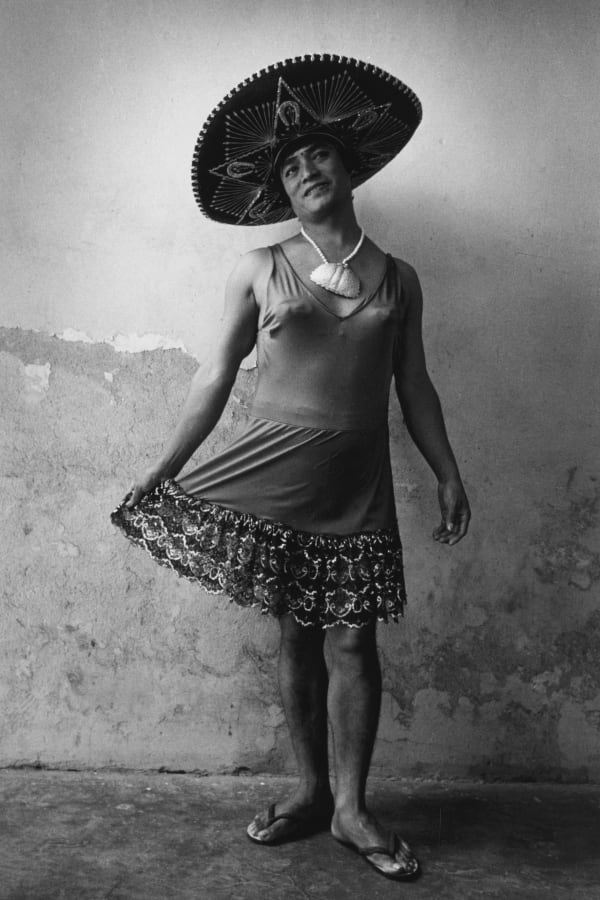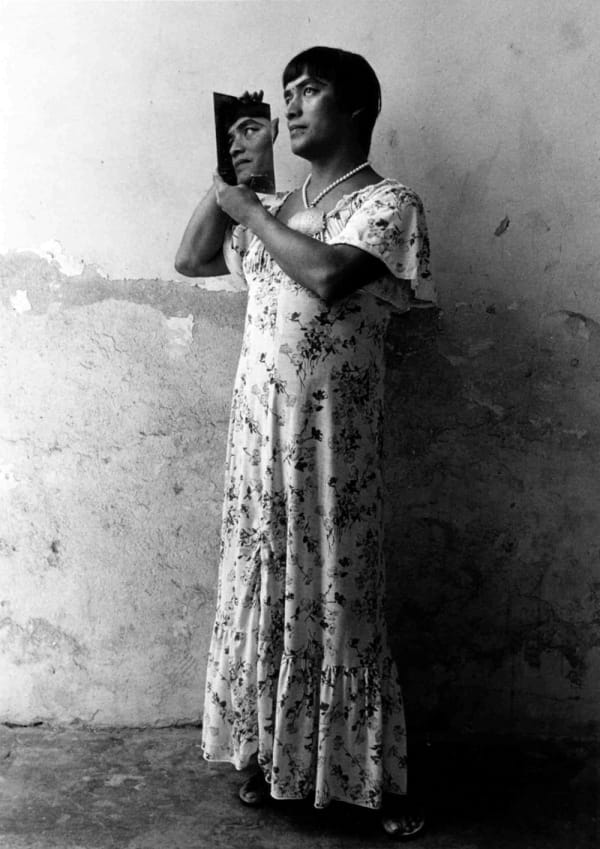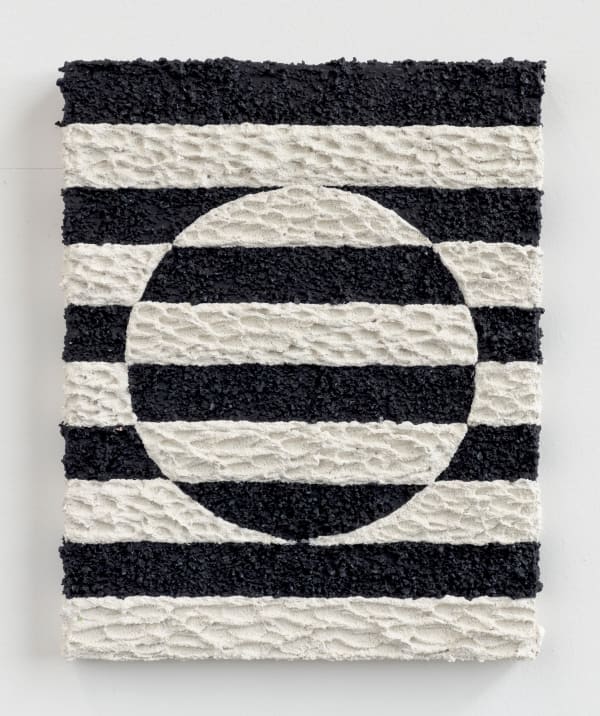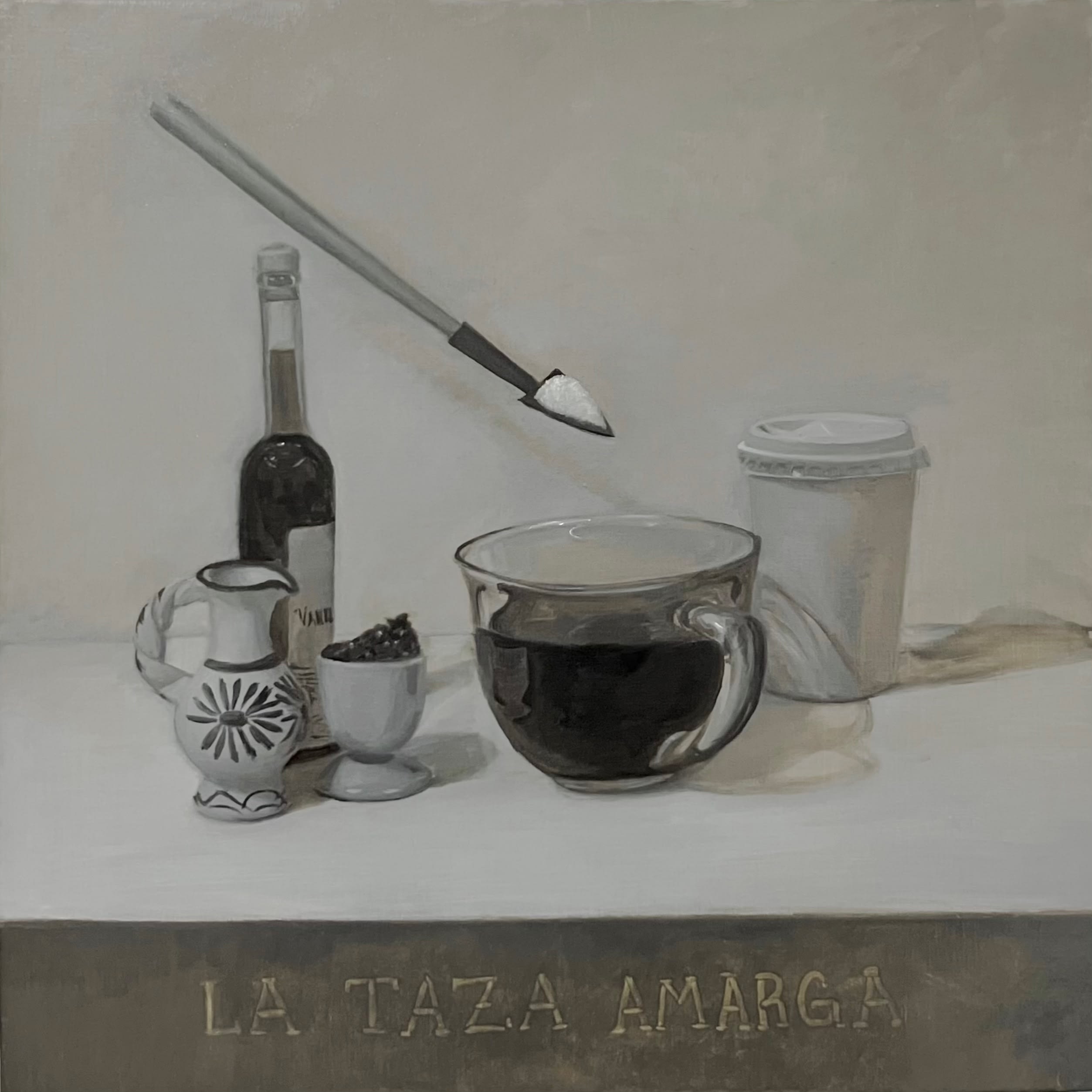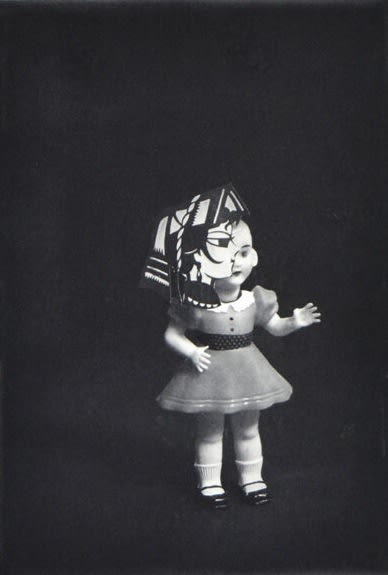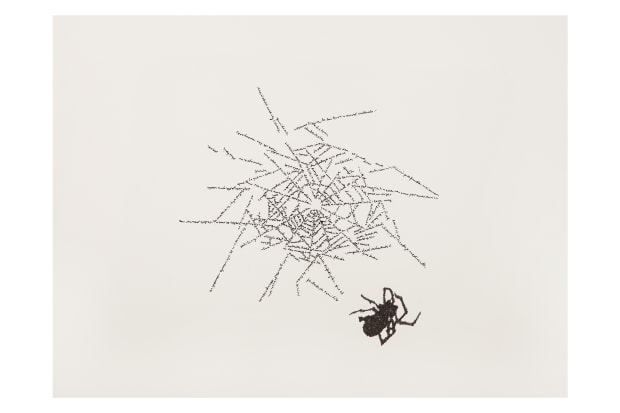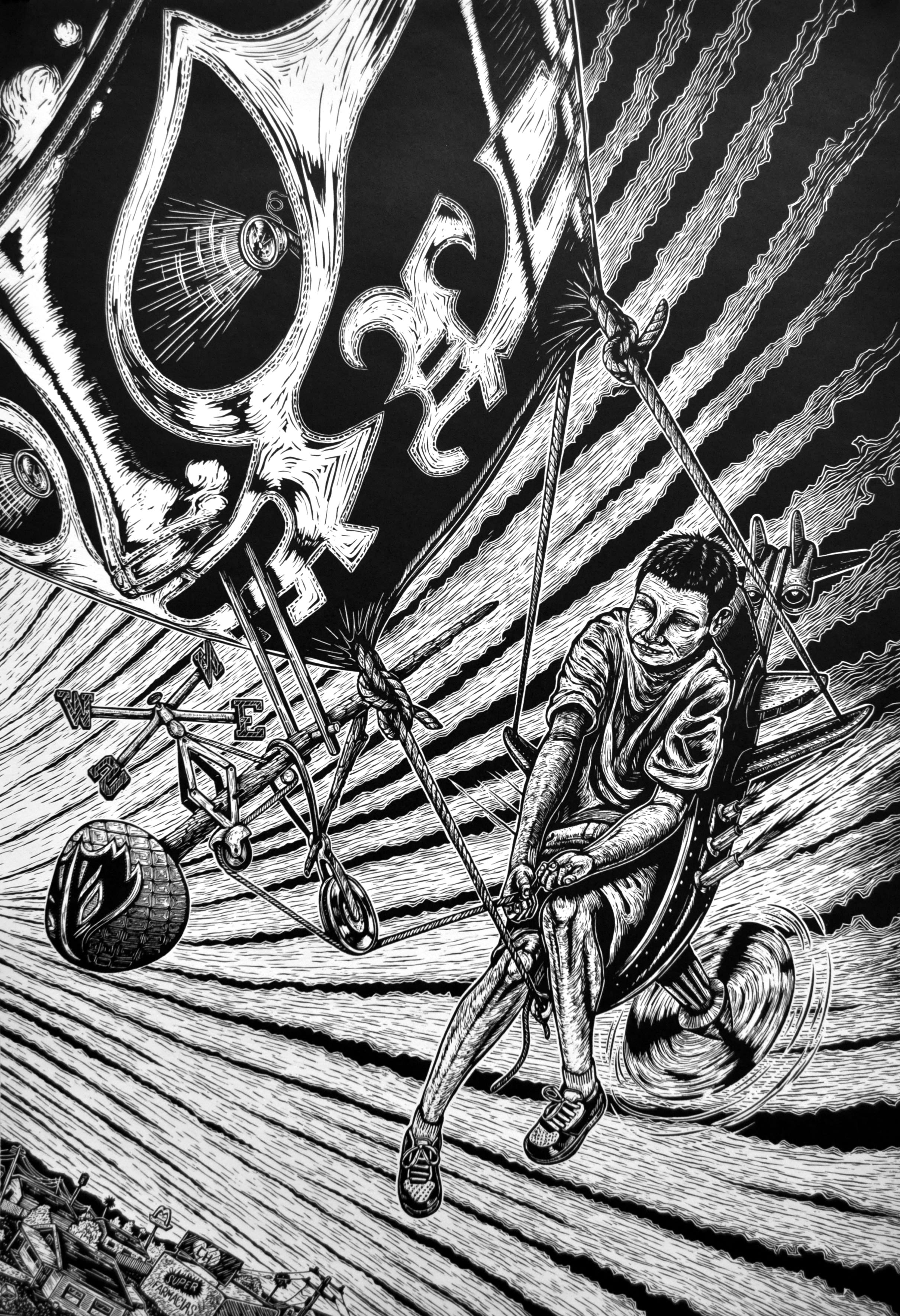-
Between Light and Shadow
New York -
Ruiz-Healy Art is pleased to present Between Light and Shadow, a group exhibition of works by Carlos Amorales, Modesto Bernardo, Johanna Calle, Jean Charlot, Felipe Ehrenberg, Demian Flores, Azteca de Gyvés, Kati Horna, Graciela Iturbide, Dr. Lakra, Juan de Dios Mora, Liliana Porter, Audrey Rodríguez, and Carlos Rosales-Silva on view from February 6th to March 14th, 2025, at our New York City gallery. Historically, black and white have been used to explore the interaction of opposites - illumination and obscurity, presence and absence - mirroring broad philosophical and cultural inquiries. Between Light and Shadow encourages looking behind the curtain of color through various mediums - including photography, painting, mixed media, and printmaking, focusing on the interplay of light & shadow, texture, and composition.
-
Graciela Itubide spent almost a decade working in her celebrated Juchitan de las Mujeres series. Iturbide’s photograph Magnolia con Sombrero, Juchitán, México, spotlights Magnolia, who resides in the town of Juchitan, a Oaxacan community that widely accepts the existence of three genders. Magnolia, a Muxe who does not identify as male or female, was photographed by Iturbide in an array of wardrobes and makeup styles, unraveling the constructed idea of gender.
Juchitán de Zaragoza, a small town on the Isthmus of Tehuantepec in the Mexican state of Oaxaca, there is a large population of a third gender known as Muxes. They have been celebrated since pre-colonization times. The broader acceptance of a third gender among the Zapotec people in Oaxaca may be traced to the belief that individuals who identify as Muxes (pronounced mu-shay) are part of the culture and its traditions, not separate from it. They maintain traditional dress, the Zapotec language, and other cultural traditions that are less prevalent among the broader Zapotec community. The Isthmus of Tehuantepec is known for its beautiful Tehuana dresses, influenced by Chinese and Southeast Asian silks unavailable to other regions of the Americas. The trade of these garments helped establish a matriarchal society where women were financially independent, contributing to the acceptance of Muxes in the region.
-
 Azteca de GyvésHuipil Negro, 1989Oil on canvas43.5 x 59.25 in
Azteca de GyvésHuipil Negro, 1989Oil on canvas43.5 x 59.25 in
110.5 x 150.5 cmFor artist Azteca de Gyvés, abstracting culturally significant objects through painting and mixed media connects Mexican Indigenous culture and the historical canon of Western art. De Gyvés geometrically abstracts a Huipil, a traditional garment deeply rooted in indigenous cultures in Mexico, pulling from her Zapotec heritage, transforming it into a universal language, creating a dialogue between past and present.
-
“There's a consistent influence of the landscape and architecture and the artists that I grew up along the border of Texas, Mexico, and El Paso. I'm constantly looking back at the landscape, looking back at the architecture.”
- Carlos rosales silva
-
-
In her photographic series, Horna offered a decidedly unromanticized and often eroticized vision of femininity and sexuality. Among these series is Oda a la necrofilia, published in 1962 in the avant-garde journal "S.nob," directed by the writer Salvador Elizondo, in which Horna coordinated the Fetiches section. This series—a visual narrative in which an enigmatic female protagonist covered by a black veil removes her clothing bit by bit while interacting with an unmade bed, a white mask, an open book, an umbrella, and a candle—evokes the ambiguous, erotic attraction provoked by an unrepresentable subject: death. Horna’s experiences of the war in Spain left a deep imprint in her later work. Some of her most personal series explores themes of disillusion, displacement, and loss, oftentimes with a refined sense of irony that can be traced back to the satirical, anti-fascist work of her early years in Europe.
-
 Audrey RodriguezNeutral Levitation IV, 2025Oil on linen14 x 14 in
Audrey RodriguezNeutral Levitation IV, 2025Oil on linen14 x 14 in
35.6 x 35.6 cm -
“Neutral Levitation IV nods to the interconnected journey of coffee—from its agricultural roots to its commodification—while highlighting the labor and natural resources behind this global industry. Through monochromatic tones and carefully chosen objects, I explore the tension between tradition and modernity, personal ritual and global economics. By incorporating symbols like soil, sugar, and a floating miniature shovel, I bridge the intimate act of drinking coffee with the broader socio-economic and environmental challenges tied to its production. The floating shovel simultaneously grounds and elevates the narrative of labor, cultivation, and consumption. The text ‘La Taza Amarga’ underscores the bittersweet reality of coffee cultivation, where the enjoyment of this daily ritual is inextricably linked to the hardships tied to its production.”
- Audrey Rodriguez
-
 Felipe EhrenbergUntitled, 1968Ink on paper13.5 x 11 in
Felipe EhrenbergUntitled, 1968Ink on paper13.5 x 11 in
34.3 x 27.9 cm -
"We live in a different period. It’s much more ambiguous. Ideology can be positive or negative. It’s hard to take a position anymore. During the Cold War, things were divided between the Communists and the West. After that, it’s hard philosophically to make a distinction.” - Carlos Amorales
-
 Carlos AmoralesSelected Ghosts #21, 2008Drawing cut out black tape on heavy paper45.25 x 35.375 in
Carlos AmoralesSelected Ghosts #21, 2008Drawing cut out black tape on heavy paper45.25 x 35.375 in
114.9 x 89.8 cm -
 Jean CharlotMystery Play series, 1926drawing17 x 19 in
Jean CharlotMystery Play series, 1926drawing17 x 19 in
43.2 x 48.3 cm -
Liliana Porter is a multimedia artist born in Buenos Aires, Argentina. Porter's works explore the ambiguous space between reality and representation. The artist places her diverse cast of characters in unconventional and hyperbolic circumstances that acknowledge their absurdity and invite philosophical rumination on existence, time, and the extent to which reality can be bent. Drawing from an eclectic collection of figurines, knickknacks, toys, and souvenirs, Porter features these characters in unexpected combinations and circumstances.
-
The San José Museum of Art explains, “Porter consistently draws from an eccentric cast of toys, miniature figures—including the likenesses of Mickey Mouse, Elvis Presley, Che Guevara, and Jesus Christ—and other objects to create theatrical vignettes that invite existential meditations on the human experience.”
-
 Johanna CalleSin Título (Arañas) Antiquus Editores, Bogotá, Colombia, 2015Ink drawing on serigraph8.8 x 11.8"
Johanna CalleSin Título (Arañas) Antiquus Editores, Bogotá, Colombia, 2015Ink drawing on serigraph8.8 x 11.8"
22.3 x 30 cm18 / 20 -
 Juan de Dios MoraAsi Como Voy, Asi Llego, 2016Linocut29.3 x 19.8 in
Juan de Dios MoraAsi Como Voy, Asi Llego, 2016Linocut29.3 x 19.8 in
74.4 x 50.3 cmEdition of 10Juan de Dios Mora was born in Yahualica, Mexico, and moved to the border town of Laredo, Texas when he was fourteen. His works are inspired by the Latino immigrant experience, paying homage to the community’s resilience, ingenuity, and ability to transform humble objects into something beautiful. As part of The Crazy Devices series, this particular linocut depicts a boy in a flying contraption with a lucha libre mask used as a parachute and a carved wooden goat mask on the back. Mora describes his subjects as characters whose devices are creative, surreal, and reflective of their will to survive in a new environment.
-
 Modesto BernardoMemoria Negra, 1994Linoleum14 x 15.5 in
Modesto BernardoMemoria Negra, 1994Linoleum14 x 15.5 in
35.6 x 39.4 cmEdition 19 of 20 -
 Graciela IturbideFrancisco Toledo and Xolo, Juchitan, Oaxaca, 1995Silver Gelatin Print
Graciela IturbideFrancisco Toledo and Xolo, Juchitan, Oaxaca, 1995Silver Gelatin Print
14 x 11 in
35.6 x 27.9 cm"Francisco is a famous painter and a good friend of mine. We often work together, and we play around while taking photographs. Francisco has opened a bunch of museums and libraries for the people of Oaxaca; in the photo, he is playing with his hairless dog Xolo. Francisco is originally from the town of Juchitán, and it was he who invited me [back in the seventies] to photograph the Zapotec culture for a book, titled Juchitán de las mujeres [The Women of Juchitán].”
-Graciela Iturbide
-
Dr. Lakra is an artist and tattooist living and working in Oaxaca, Mexico. Born Jerónimo López Ramírez, he renamed himself Dr. Lakra (or Dr. Scar) in reference to the medical briefcase in which he carries his equipment and recognition of his manipulation of found imagery and objects. He also creates collages and drawings, which started as sketches for his tattoos. Using various sources of iconography to depict a wide variety of content, the artist focuses on the juxtaposition of new and old. Other themes include vulgarity, religion, taboos, repression, sex, and violence.
-
 Demian FloresUntitled (clown)Dry point etching13.25 x 13.25 in
Demian FloresUntitled (clown)Dry point etching13.25 x 13.25 in
33.7 x 33.7 cm17 / 30
Between Light and Shadow: New York
Past viewing_room


